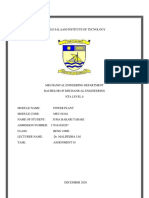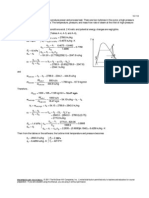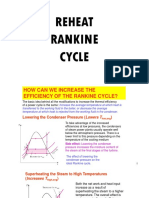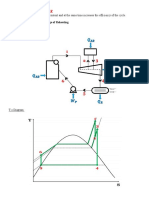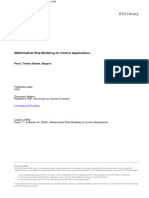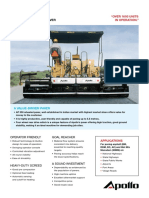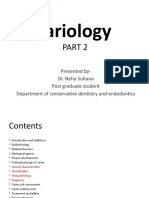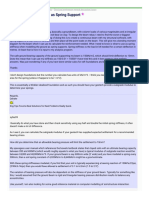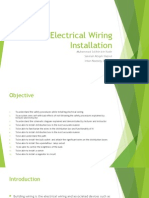THERMO 2B (Thermodynamics 2)
BS in Mechanical Engineering 2A
Second Semester SY: 2024-2025
Topic 1
SIMPLE RANKINE CYCLE ANALYSIS
SAMPLE PROBLEM
1. Steam is generated at 4.10 MPa and 440°C and condensation occurs at 0.105 MPa. For a
Rankine Engine operating between these limits, Compute:
a.) Heat Added (QA), Heat Rejected (QR), Net Work (Wnet), Thermal Efficiency (eth)
b.) What mass flow rate is required for a net output of 30,000 kW?
Illustrations:
Pressure of steam at point 1;
P1 = 4.10 MPa & 440°C
Pressure of the
condensed substance
(water) at point 3;
P3 = 0.105 MPa
T-S Diagram:
Processes:
1-2: Isentropic Expansion
2-3: Isobaric Heat Rejection
P1 =4.10 MPa
3- & 440°C
4: Isentropic Compression
4-1: Isobaric Heat Addition
P3 =0.105 MPa
SOLUTION:
From Steam Table:
At P1 = 4.10 MPa & 440°C, we obtained the following values of its thermodynamic properties as
follows:
(1) enthalpy h1 = 3305.7 kJ/kg
(2) entropy s1 = 6.8911 kJ/kg-°K
Pssssssssst... Hello!
This is how we get values
from the Steam Table…
At Table 3. Vapor
� Remember that at point 1 during
isentropic expansion, the steaming
pressure is P1 = 4.10 MPa with a
saturation temperature of tsat. =
251.87°C. But since the actual
temperature of steam produced by
the boiler is 440°C, the quality of
steam is already a “Superheated
Steam” because of its temperature
that is higher than saturated vapor.
This is how we classify the quality
of steam:
Highly Superheated
Superheated
Saturated
Wet
Actual temperature of
steam produced by the
boiler; t1 = 440°C thus,
SUPERHEATED STEAM
Solving for h2:
Since the quality of steam at point 2 is already a mixture of dry & wet steam, we will use the
following formula:
h2 = hf2 + (x2) (hfg2)
where:
h2 = enthalpy of a mixture at point 2
hf2 = enthalpy of fluid at point 2
x2 = quality of the mixture at point 2
� hfg2 = enthalpy of the mixture at point 2
Also;
where:
x2 = (s2 – sf2) / sfg2
But Since;
S1 =(3) s2 = 6.8911 kJ/kg-°K (from T-S diagram)
From: Table 2. Saturation: Pressure @ 0.105 MPa
hf2 = 423.24 kJ/kg
hfg2 = 2254.4 kJ/kg
sf2 = 1.3181 kJ/kg-°K
sfg2 = 6.0249 kJ/kg-°K
0.105 MPa
Thus;
� x2 = (6.8911 – 1.3181) / 6.0249
= 0.925 or 92.5% Dry Steam
Solving for h2:
h2 = 423.24 + (0.925) (2254.4)
h2 = 2508.6 kJ/kg
Solving for h3:
h3 = hf @ 0.105 MPa
h3 = 423.24 kJ/kg
Solving for h4:
h 4 = h3 + W p
where:
Wp = Pump Work
= vf3 (P4 – P3)
also, where:
vf3 = from Steam Table; vf at 0.105 MPa = 1.0443 x 10³ m³/kg or 0.0010443 m³/kg
P4 = P1 (in KPa) = 4100 kPa
P3 = P3 (in KPa) = 105 kPa
thus:
Wp = (0.0010443) (4100 – 105)
= 4.17 kJ/kg
h4 = 423.24 + 4.17
h4 = 427.4 kJ/kg
A. Heat Added;
QA = (h1 – h4)
= (3305.7 – 427.4)
QA = 2878.3 kJ/kg
Heat Rejected;
QR = (h2 – h3)
= (2508.6 – 423.24)
QR = 2085.4 kJ/kg
Net Work;
� Wnet = QA – QR
= (2878.3 – 2085.4)
Wnet = 792.9 kJ/kg
or;
Wnet = (h1 – h2 – Wp)
= (3305.7– 2508.6 – 4.17)
Wnet = 792.9 kJ/kg
Thermal Efficiency;
eth = Wnet / QA
= 792.9 / 2878.3
eth = 0.2755 or 27.55%
B. Steam Flow
= 30,000 kW / Wnet
= 30,000 kW / 792.9 kJ/kg
= 37.84 kg/s
**END**








